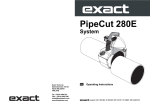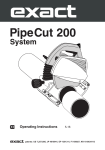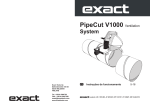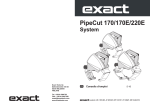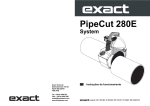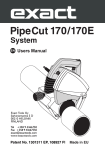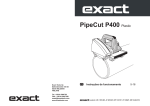Download eXact PipeCut 280E System Operating instructions
Transcript
PipeCut 280E/360E System Exact Tools Oy Särkiniementie 5 B 64 00210 HELSINKI FINLAND Tel + 358 9 4366750 FAX + 358 9 43667550 [email protected] www.exacttools.com EN Operating Instructions 5-16 patents: US 7,257,895, JP 4010941, EP 1301311, FI 108927, KR 10-0634113 Exact PipeCut 280/360 System Blade information for Exact PipeCut saws TCT (tungsten carbide tip) saw blades are for cutting steel, copper, aluminium and all kind of plastics. TCT blades can be sharpened. Cermet (ceramic alloy tip) saw blades are for cutting stainless steel, acid proof materials, steel, copper, aluminium and all kind of plastics. Cermet blades can be sharpened. Diamond blades are for cutting cast iron only. Diamond blades can not be sharpened. 280E/360E speed control recommendations: Stainless steel I Steel II Cast-iron II Plastics II 2 A 1. 2. 3. 4. 5. 6. 7. 8. 9. 10. 11. 12. 13. 14. 15. 16. 17. 18. 19. 3 Declaration of Conformity We declare under our sole responsibility that the pipe cutting machine, Exact PipeCut 280E/360E described under “Technical Data” are in conformity with the following standards or standardization documents: EN60745-1, EN60745-2-5, EN55014-1, EN 55014-2, EN61000-3-2, EN61000-3-3 according to the provisions of the directives 2004/108/EC, 2006/42/EC. For more information, please contact Exact Tools at the following address. The technical file is available at the address underneath. The person authorized to compile the technical file: Mika Priha, R&D manager ([email protected]) Helsinki, 31.08.2012 Seppo Makkonen, Managing director Exact Tools Oy Särkiniementie 5 B 64 FI-00210 Helsinki Finland 4 Contents The original language of this manual is english english Contents 6. 7. Technical data Package contents Safety 8. Safety instructions Operation 10. 10. 11. 11. 11. 11. 12. 12. 12. 13. 13. Functional description Product features Before operating the tool Connection to the mains power supply Precise setting of the cutting point Setting the pipe on supports Attaching the pipe saw to the pipe Piercing the pipe wall Sawing around a pipe Overload protection and rotation speed control Straightness of cut and adjusting wheel 14. Installing and changing the saw blade 14 Service and maintenance instructions 16. Environment/Disposal 16. Guarantee/Guarantee conditions 16. Tips for users Exploded view (separate attachment) Definitions: Safety guidelines The definitions below describe the level of severity for each signal word. Please read the manual and pay attention to these symbols. DANGER: Indicates an imminently hazardous situation which, if not avoided, will result in death or serious injury. WARNING: Indicates a potentially hazardous situation which, if not avoided, could result in death or serious injury. CAUTION: Indicates a potentially hazardous situation which, if not avoided, may result in minor or moderate injury. NOTICE: Indicates a practice not related to personal injury which, if not avoided, may result in property damage. Denotes risk of electric shock. 5 Information english Operating, safety, and servicing instructions Please read this operating, safety, and servicing instructions carefully before using the pipe saw. Also store this instruction book somewhere accessible to everyone using the pipe saw. In addition to these instructions, always follow the official work, health and safety regulations. The Exact PipeCut is meant for professional use only. Technical data Model Voltage 1 Power No-Load speed Intermittent operation Blade diameter Mounting bore Weight 280E Weight 360E Range of use Ø 280E Range of use Ø 360E Max. pipe wall steel Max. pipe wall plastics Protection class Spindle lock Speed preselection Constant electronic control Overload Protection Reduced starting current Vibration LpA (sound pressure) KpA (sound pressure uncertanity) LWA (acoustic power) KWA (acoustic power uncertanity) Pipecut 280/PipeCut 360E 230V-240 V / 50-60 Hz also 110V-120V / 50-60 Hz 1750 W I (low) = 2900 /min, II (high) = 3900 /min 2,5 min ON / 7,5 min OFF (S3 25% 10 min) 165 mm (6,50”) 62 mm (2,44”) 9,0 kg (20 lbs) 14,5 kg (32 lbs) 40 mm – 280 mm (1,6”- 11”) 75 mm – 360 mm (3,0”- 14”) 10 mm (0,4”) 38 mm (1,5”) / II Yes Yes Yes Yes Yes 2,84 m/s2 90,6 dB(A) 3 dB(A) 103,6 dB(A) 3 dB(A) The values given are valid for nominal voltages [U] of 230/240V. For lower voltage and models for specific countries, these values can vary. Please observe the article number on the type plate of your machine. The trade names of the individual machines may vary. Only for power tools without reduced starting current: Starting cycles generate brief voltage drops. Interference with other equipment/machines may occur in case of unfavourable mains system conditions. Malfunctions are not to be expected for system impedances below 0.36 ohm. 6 Information english Noise/Vibration Information Measured values determined according to EN60745. Wear hearing protection! Vibration total values (triax vector sum) determined according to EN60745: Vibration emission value ah =2,84 m/s2, UncertaintyK =1.5 m/s2. The vibration emission level given in this information sheet has been measured in accordance with a standardised test given in EN 60745 and may be used to compare one tool with another. It may be used for a preliminary assessment of exposure. WARNING: The declared vibration emission level represents the main applications of the tool. However if the tool is used for different applications, with different accessories or poorly maintained, the vibration emission may differ. This may significantly increase the exposure level over the total working period. An estimation of the level of exposure to vibration should also take into account the times when the tool is switched off or when it is running but not actually doing the job. This may significantly reduce the exposure level over the total working period. Identify additional safety measures to protect the operator from the effects of vibration such as: maintain the tool and the accessories, keep the hands warm, organisation of work patterns. Exact PipeCut 280E/360E pipecutting system, Package contents: Please check the package contains the following items: 1. Pipecutting System case 2. Exact PipeCut 280E or 360E pipe saw 3. Cutting supports × 4 (1+2 model 360E) 4. Operating instructions 5. Hex socket key 5 mm and 2 mm fitted to the machine 6. TCT blade 165 × 62 fitted on the machine 7. DVD-video disc with instructions 1. 4. 3. 280E 2. 280E 2. 360E 5. 6. 3. 360E 7. 7 Safety english 8 Safety english 9 Safety english Intended Use PipeCut 280E/360E: The PipeCut 280E/360E pipe saw is intended for use as a pipe fitter’s tool at the installation site. The PipeCut 280E/360E pipe saw can only be used to cut round pipes, with a diameter of 280E: 40 mm – 280 mm (1.6”-11”) or 360E: 75 mm – 360 mm (3”-14”) and a maximum wall thickness of 10 mm (0.4”) with steel and other ferrous and non-ferrous materials and 38 mm (1.5”) with plastics. The PipeCut 280E/360E pipe saw can be used to cut all normal pipe materials, such as steel, stainless steel, cast iron, copper, aluminium and plastic. PipeCut 280E/360E pipe saw is intended for short, intermittent use. The machine may be loaded for 2,5 minutes during a 10-minute period (S3 25 %). PipeCut 280E/360E pipe saw is not intended for use in industrial production. Use pipe holders to support pipe. Product Features While reading the operating instructions, unfold the graphics page for the machine and leave it open. This page is folded under the cover of this manual (page 3). The following numbering of the product features refers to this illustration. Figure A 1. 2. 3. 4. 5. 6. 7. 8. 9. 10. 11. 12. 13. 14. 15. 16. 17. 18. 19. 10 UNLOCK button Power switch Power-switch locking lever Blade-guard cover Overload indicator light Moving blade-guard Edge of moving blade-guard Adjustable wheel Operating handle Chip removal lever Chip removal nozzle Blade-guard screw Spindle-lock button Rating plate Motor unit Speed control Gripper unit Gripper safety Gripper adjustment handle Operation english Exact PipeCut 280E/360 pipecutting system operating instructions Fig B open closed Before operating the tool - Ensure that the motor unit is in the upright position. The yellow mark of the UNLOCK button is visible. - Check that the blade is correctly fitted, in good condition and suitable for the material to be cut. - Ensure the pipe saw guide wheels rotate. - Ensure the support wheels rotate. - Check the operation of the lower blade guard. - Ensure the pipe is empty. - Check the position of chip removal lever. The pipe saw is equipped with a nozzle for removing chips. When sawing plastic pipes, turn the chip removal lever (Fig A/10) to "open" position (Fig B), which opens the hatch in the blade housing. If you attach a vacuum cleaner to the chip removal nozzle, most of the plastic chips will then fly out of the chip removal nozzle (Fig A/11) and won't remain inside the blade housing. When sawing metal pipes, turn the lever to "close" position (Fig B). The metal chips will drop out from the bottom of the blade housing. Never attach a vacuum cleaner when cutting metal pipes. Connection to the mains power supply Ensure that the mains voltage is the same as indicated on the rating plate (Fig A/14). Connect the pipe saw to the power outlet only after having checked this. Precise setting of the cutting point When you mark the cutting point on the pipe to be cut, deduct 20 mm from the required dimension (Easy-to-remember rule: The cutting mark location requires a measurement of - 20 mm.) (Fig C) Fig C Cutting point Cutting mark Fig D Fig E Setting the pipe on supports Use the system supports when cutting pipes. This will ensure safe working and optimum result. Work on flat surface. Place the pipe on two supports so that the cutting point is between the supports. Place two more support under both ends of the pipe. Check that all support wheel contact the pipe (adjust if required e.g. with pieces of lumber) (Fig D). When cutting short pipes (25 cm or less) place the supports so that the cutting point is outside supports (Fig E). Support the pipe with your left leg, if required. Proper arrangements will prevent the blade from jamming as the pipe is cut through. 11 Operation english Fig F Attaching the pipe saw to the pipe Open the pipe saw’s gripper unit enough to suit the diameter of the pipe by rotating the adjustment handle located at the rear of the saw (Fig. F/1). Position the pipe saw on top of the pipe so that the edge of the lower blade guard is at the cutting mark. Fasten the pipe saw to the pipe by turning the gripper adjustment handle until the gripper grips firmly the pipe to be cut (Fig F/2). Lock the mechanism by turning the gripper safety (Fig F/3). Hold the pipe in place and ensure that pipe saw moves freely in the direction the pipe is fed. For sake of safety ensure the pipe saw leads are to the left of the pipe saw. The pipe saw is now ready for cutting. Piercing the pipe wall Fig G Grip the gripper firmly with your right hand and place your left foot on top of the pipe approximately 50cm from the pipe saw. Turn the saw until it leans slightly forward (Figure I). When starting the motor, first of all release the power-switch locking lever (Fig G/1) and push the power switch all the way down (Fig G/2). Before starting to saw, wait until the blade reaches full speed. Pierce the pipe wall by pressing pipe saw operating handle downwards slowly and evenly until the blade has cut through the pipe wall (at this stage the pipe must not rotate) and the motor unit is locked in the sawing position (Fig I /1).. Look at the UNLOCK button during the piercing operation. When UNLOCK button is locked, i.e. the yellow mark disappears (Fig H), pipe saw is locked in the sawing position, and you can safely start sawing around the pipe. Fig H Sawing around the pipe Start sawing by feeding the pipe saw forward and fix the pipe with your left foot (Fig I /2). After that release the pipe (remove your left foot from the pipe) and turn the pipe saw backwards, whereby the pipe will also be rotated backwards (Fig J). Start a new feeding movement, and feed continuously forward ca. 1/6 of the pipe’s circumference. Repeat until the pipe is cut off (Fig K). Fig I 1 2 Select the sawing / feeding speed as per the material and the thickness of the wall. Too high speed can damage the blade, overload the pipe saw and give a poor sawing result. 12 Operation english Fig J When the pipe is cut off, push the UNLOCK button forward until the yellow mark is visible and the locking is released (Fig L/1). Now raise the motor unit to starting position (Fig L/2). Release the power switch (Fig L/3). When the blade has stopped, open the gripper safety mechanism (Fig L/4) and disengage the pipe saw from the pipe by loosening the gripper adjustment handle. (Fig L/5). Ensure that the moving lower blade-guard is lowered into safety position Should there be problems during piercing or sawing, abnormal sounds or vibrations due to which you have to interrupt sawing before the pipe is cut through, release the blade by pushing the UNLOCK button forward until the UNLOCK button is released, and lift the motor unit up. Once the problem is cleared, start sawing again. Fig K 1/8 Never start the motor, when the motor unit is locked in sawing position or teeth of the blade contact the pipe to be sawn. Overload protector and rotation speed control The saw has a two-speed rotation speed control (Fig A/16). When sawing stainless or acid-proof steel use the lower rotation speed l. When sawing other materials use the faster rotation speed ll. The saw also has an overload protector which switches the power off automatically in an overload situation. The motor part has a red indicator light (Fig A/5), which flashes alerting you to the overload and is lit continually when the overload protector has been triggered. If the light begins to flash, the motor must be cooled down. Stop sawing and allow the motor to cool down. You can speed up the cooling process by running the motor without loading it. When the motor has cooled down sufficiently, the light will stop flashing or turns off and you can continue sawing. Fig L 5 4 Straightness of cut and adjusting wheel The cut is affected by many factors, e.g. the size of the pipe, the material, the wall thickness, the quality of the pipe’s surface, the roundness, welded seams, blade condition, feed rate, operator’s experience. For this reason the result may vary, and the cut may turn to left or right (misalignment of the cut’s starting and ending point) (Fig M). The pipe saw gripper has one adjustable wheel (Fig A/8) which be used for improving the quality of the cut and for reducing the misalignment. Fig M The adjustment applies only to the actual pipe size and material, and the wheel may have to be readjusted as the blade is worn. Step to left 13 Step to right Operation english Fig N To adjust the wheel, loosen the locking screw (Fig N/1) and turn the wheel centre clockwise or counter clockwise to the desired position (Fig N/2), and lock the wheel again (Fig N/3). If the blade has wandered too much to the left, adjust wheel centre clockwise (- sign). If the misalignment is to the right, adjust counter clockwise (+ sign). The extent of the adjustment depends on the actual misalignment. Remember to lubricate the adjusting wheel at regular intervals. Installing and changing the saw blade WARNING: To reduce the risk of injury, turn unit off and disconnect it from power source before installing and removing accessories, before adjusting or when making repairs. An accidental start-up can cause injury. Fig O Remove the power plug from the socket. Check that the motor unit is locked in the upper position. Remove the blade guard cover (Fig. O/1) by opening the screw (Fig. O/2). Press the spindlelock button (Fig. A/13) and simultaneously rotate the blade by hand until the spindle-lock button drops a further distance of about 7 mm. Now the rotation of the blade is prevented. Use the blade key to open the blade attachment bolt. Remove the securing bolt (Fig. O/3), the washer (Fig. O/4), the blade flange disc (Fig. O/5), and the blade (Fig. O/6). Before installing a new blade, check that both blade flange discs are clean. Place a new or sharpened blade on the back flange disc (Fig. O/7), so that the marked side of the blade is facing outwards and the arrows on the blade are facing in the same direction as the rotation direction markings on the inside of the blade case. Ensure that the new blade goes right to the bottom in the back flange disc. Put the blade flange disc, the washer, and the securing bolt back in place. Press the spindle lock button and tighten the blade securing bolt. Put the blade guard cover back in place and tighten the finger bolts. Fig P 4 3 2 Maintenance and servicing instructions 1 Remove the power plug from the socket before servicing or cleaning the pipe saw. All maintenance operations carried out on the pipe saw’s electrical components must be carried out at an approved service agency. 14 Maintenance, Environment, Guarantee english Environment Blade Check the condition of the blade. Replace a bent, blunt, or otherwise damaged blade with a new one. Using a blunt blade can overload the pipe saw’s electric motor. When you notice that the blade is blunt, do not continue sawing with it, as the blade may become so badly damaged that it will not be worth sharpening. A blade in sufficiently good condition can be sharpened a few times by a professional sharpening company. Separate collection. This product must not be disposed of with normal household waste. When your Exact PipeCut machine is worn out, do not dispose of it with normal household waste. This product must be recycled separately. Separate recycling of used products and packaging facilitate recycling and recovery of materials. Reusing of recycled materials helps prevent pollution of environment. According to local regulations it is possible to deliver household appliances to municipal rubbish depositories or to the dealer when buying a new product. Gripper unit Clean the gripper unit regularly with compressed air. Lubricate the gripper’s wheel axles (Fig. P/1) and its joints (Fig. P/2). Also clean and lubricate the gripper’s trapezoidal screw (Fig. P/3) and the two worm screws on it (Fig. P/4). Guarantee Blade guard When you have sawn plastic pipes and then intend to start sawing metal pipes always clean the inside of the blade guards. Hot particles derived from sawing metal will burn plastic particles, which may release toxic smoke. Make it a rule to clean the blade guard regularly, and pay special attention to keep the moving blade guard movement from becoming hampered. Lubricate the axis of the moving blade guard regularly. If the Exact PipeCut pipe saw becomes unusable due to material or manufacturing faults within 24 months of the date of purchase, we will replace the damaged parts with new ones or supply an entirely new or factory-reconditioned pipe saw to replace the damaged one. The guarantee is only valid if: The guarantee card or a dated purchase receipt is returned to the manufacturer or retailer. The pipe saw has not been misused. No attempt has been made by non-approved persons to repair the saw. The pipe saw has been used in accordance with these operating, safety, and servicing instructions. The guarantee does not apply to blades or the overload protection. Motor Keep the motors cooling vents clean. Plastic parts Clean the plastic parts with a soft rag. Only use mild detergents. Do not use solvents or other strong detergents as they may damage the plastic parts and paint surfaces. Due to continuous product development, the information in this instruction book may change. We do not give separate notification of changes. Power cable Check the condition of the power cable regularly. A faulty power cable should always be replaced at an approved service agency. Correct use and regular servicing and cleaning will ensure the continued operation of the pipe saw. 15 Tips english Tips for using Exact PipeCut saws Factors that affect the lifetime of the saw blade: • • • • • • • • • • • Diamond blade should only be used for cutting cast iron pipe. It is not recommended to cut cast iron with TCT or Cermet blades. Clean the inside of the blade guards after cutting plastic pipe. Smaller pipe is easily cut by rotating the pipe by hand either on a table or on the floor. Please note: rotate pipe towards you when rotating by hand and be careful not to rotate too fast. Check the condition of the blade regularly. material of the pipe correct blade type for material being cut correct motor speed setting wall thickness of the pipe feeding speed smoothness of the pipe user’s general skills cleanness of the pipe rust on the pipe welded seam in the pipe blade speed Factors that affect the straightness of the cut: The cutting procedure is divided into two stages; first saw through the pipe wall, then complete the cut by sawing around it. • • • • • • • • • Do not overload the saw by cutting continuously. The saw will be overheated and the metal parts can become burning hot. This will also damage the motor and the blade. The rule is 2.5 minutes in use and 7.5 minutes rest. Keep the feeding speed constant. This will extend the lifetime of the blade. For example cutting time for a steel pipe diameter of 6’’ (170mm), and a wall thickness of 1/5’’ (5mm), is 15-20 seconds, and for a cast-iron pipe diameter of 4’’ (110mm), with a wall thickness of 1/6’’ (4mm) is 20 to 25 seconds. condition of the saw blade wall thickness of the pipe feeding speed smoothness of the feed user’s general skills cleanness of the pipe roundness of the pipe gripper unit too loose or too tight blade assembled too tight Please see more information at our web-site www.exacttools.com Always keep the motor unit in the upright position. The yellow mark of the unlock button is then visible. Never place the Pipe Cut Saw on the pipe in the locked / cutting position. 16
















